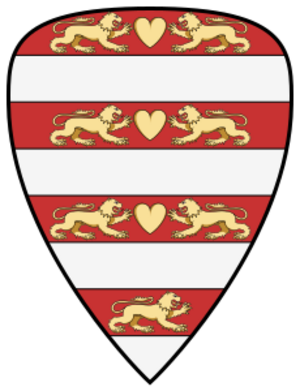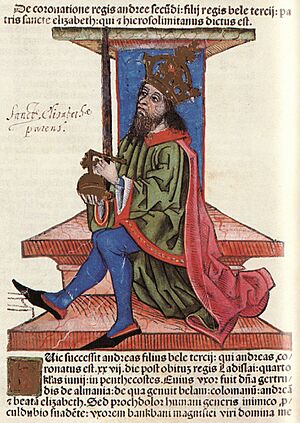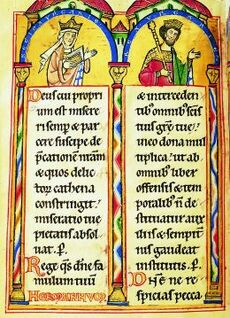Andrew II of Hungary facts for kids
Quick facts for kids Andrew II |
|
|---|---|
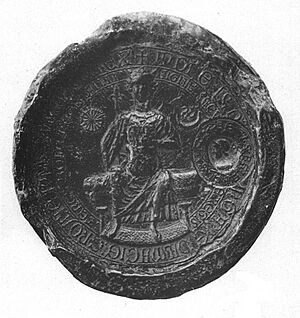
Seal of Andrew II, 1224
|
|
| King of Hungary and Croatia | |
| Reign | 7 May 1205 – 21 September 1235 |
| Coronation | 29 May 1205, Székesfehérvár |
| Predecessor | Ladislaus III |
| Successor | Béla IV |
| Prince of Halych | |
| Reign | 1188–1189 or 1190 1208 or 1209–1210 |
| Predecessor |
|
| Successor |
|
| Born | c. 1177 |
| Died | 21 September 1235 (aged 57–58) |
| Burial | Egres Abbey |
| Spouse |
|
| Issue |
|
| Dynasty | Árpád |
| Father | Béla III of Hungary |
| Mother | Agnes of Antioch |
| Religion | Roman Catholic |
Andrew II (born around 1177, died September 21, 1235) was a powerful ruler. He was the King of Hungary and Croatia from 1205 to 1235. He was also known as Andrew of Jerusalem. Andrew was the younger son of Béla III of Hungary. His father gave him control of the Principality of Halych in 1188. However, the local noblemen, called boyars, soon forced him out.
Andrew became king after his older brother, King Emeric of Hungary, and his nephew, Ladislaus III, passed away. As king, Andrew made big changes to how royal lands were given out. He also fought many wars to control the regions of Halych and Lodomeria. In 1217, he joined the Fifth Crusade to the Holy Land, but it was not successful.
Andrew had to issue an important document called the Golden Bull of 1222. This document gave special rights to the "royal servants," who were landowners serving the king. This helped the nobles gain more power. Andrew also had disagreements with the Holy See (the Pope) because he hired Jewish and Muslim officials. He promised to change this but did not always keep his word.
Andrew's first wife, Gertrude of Merania, was killed in 1213. This happened because people were unhappy with her favoring her German relatives. Their daughter, Elizabeth of Hungary, later became a saint.
Early Life and Rise to Power
Growing Up: Andrew's Early Years (1177–1197)
Andrew was born around 1177. His parents were King Béla III of Hungary and Agnes of Antioch. Andrew first appears in history when his father invaded the Principality of Halych in 1188. King Béla III took control of Halych and gave it to Andrew to rule.
However, Andrew's rule in Halych was not popular. Hungarian soldiers were not respectful of the local people or their Orthodox churches. The local noblemen, called boyars, teamed up with the former prince, Vladimir II Yaroslavich. With help from Casimir II of Poland, they forced Andrew out of Halych in 1189 or 1190. Andrew then returned to Hungary.
His father, King Béla III, gave Andrew some fortresses, lands, and money. Before he died, King Béla III asked Andrew to lead a crusade to the Holy Land. King Béla III passed away in 1196, and Andrew's older brother, Emeric, became king.
Duke of Croatia and Dalmatia (1197–1204)
Andrew used the money he inherited to gain support from Hungarian lords. He wanted more power and formed an alliance with Duke Leopold VI of Austria. Their forces defeated King Emeric's army in 1197. After this, King Emeric had to give Andrew control over Croatia and Dalmatia. This was like a special region given to a royal family member.
Andrew ruled Croatia and Dalmatia almost like an independent king. He even made his own coins. He also took control of a region called Hum in 1198. Andrew called himself "Duke of Zadar and of all Dalmatia, Croatia and Hum."
Pope Innocent III encouraged Andrew to go on a crusade. But Andrew was busy planning against his brother, King Emeric. The Pope warned Andrew, but he did not listen. In 1199, King Emeric discovered Andrew's plans. Royal troops defeated Andrew's army, and he fled to Austria. A papal representative helped Andrew and Emeric make peace, and Andrew returned to Croatia and Dalmatia in 1200.
Andrew married Gertrude of Merania around 1200. Her family had lands near Andrew's duchy.
When King Emeric's son, Ladislaus, was born around 1200, Andrew's hopes of becoming king were dashed. The Pope even confirmed Ladislaus as the future king. Andrew planned another rebellion, but King Emeric captured him in 1203.
[All] the magnates of the kingdom and almost the whole of the Hungarian army deserted [King Emeric] and unlawfully sided with Duke Andrew. Very few men indeed remained with the king, and even they were terrified at the extent of the insurrection and did not dare to urge the king to hope for success, but rather advised him to flee. Then it happened that one day both sides had drawn close to each other and were beginning to prepare themselves in earnest for battle. ... [After] much wise thought, with inspiration from heaven [King Emeric] found a successful way by which he might recover his right to the kingdom and still remain guiltless of bloodshed. So he said to his men, "Stay here a while, and do not follow me." Then he laid down his weapons, and taking only a leafy bough in his hand he walked slowly into the enemy ranks. As he passed through the midst of the armed multitude, he cried out in a loud and strong voice, "Now I shall see who will dare to raise a hand to shed the blood of the royal lineage!" Seeing him, all fell back, and not daring even to mutter, they left a wide passage for him on either side. And then when [King Emeric] reached his brother, he took him, and leading him outside the body of troops, he sent him to a certain castle for custody.
Andrew was imprisoned but was freed in early 1204. King Emeric became very ill and had his son, Ladislaus, crowned king. Andrew made peace with his dying brother. Emeric asked Andrew to take care of his young son and rule the kingdom until Ladislaus was old enough.
Becoming King: Andrew as Guardian (1204–1205)
King Emeric died on November 30, 1204. Andrew became the guardian of Ladislaus III and ruled the kingdom. However, Andrew started acting like he was already the king. Pope Innocent told Andrew to be loyal to Ladislaus and protect the queen mother, Constance of Aragon.
But Andrew took money and property that belonged to Ladislaus and Constance. Queen Constance fled from Hungary with her son and the Holy Crown. Andrew prepared for war against Austria, but Ladislaus suddenly died in Vienna on May 7, 1205. Andrew then got the Holy Crown back.
Andrew II's Reign
New Policies and Wars in Halych (1205–1217)
John, Archbishop of Kalocsa, crowned Andrew king in Székesfehérvár on May 29, 1205. Andrew started a new way of giving out royal lands and castles. He called this the "new institutions." He gave large parts of the royal lands to his supporters. He said that "the best measure of a royal grant is its being immeasurable." This policy meant that lords now had their own lands that brought them money, instead of just getting paid for their service to the king. This also made the king's power weaker.
Andrew was very interested in the region of Halych. He launched his first campaign to take it back in 1205 or 1206. He helped the young prince, Daniel Romanovich, against his enemies. Andrew then took the title "King of Galicia and Lodomeria." This showed he claimed to rule these two areas.
After Andrew left Halych, other princes took control. Andrew often sent troops to Halych to try and put his chosen rulers in power. He even made one of his generals, Benedict, governor of Halych. But Benedict was harsh, and the boyars asked another prince, Mstislav Mstislavich, to overthrow him.
Andrew also confirmed the rights of two towns in Dalmatia, Split and Omiš.
Queen Gertrude's brothers came to Hungary in 1208. Andrew gave them large lands, which made many Hungarian lords unhappy. They felt Andrew was too generous to his wife's German relatives.
In 1210, Andrew gave land in Barcaság (now Țara Bârsei, Romania) to the Teutonic Knights. These knights were a military order. Their job was to protect Hungary's eastern borders from the Cumans and help convert them to Catholicism.
In 1213, while Andrew was away fighting in Halych, Hungarian lords who were angry with Queen Gertrude's favoritism attacked and killed her and many of her followers. When Andrew heard the news, he returned and ordered the killer to be executed. However, others involved in the plot did not get harsh punishments. Some lords even tried to replace Andrew with his young son, Béla. They failed, but Andrew had to agree to Béla being crowned king in 1214.
Andrew and Leszek I of Poland made an alliance. Andrew's second son, Coloman, married Leszek's daughter. Andrew and Leszek then invaded Halych together, and Coloman became prince. But soon, Leszek and Mstislav Mstislavich teamed up and forced Coloman to flee.
Andrew's government faced money problems. He introduced new taxes and rented out royal income from things like minting coins and salt trade. This made many people unhappy.
Andrew's Crusade to the Holy Land (1217–1218)
In 1216, Pope Honorius III again asked Andrew to lead a crusade. Andrew had put it off many times before, but this time he agreed. He hoped to become the Latin Emperor of Constantinople, as his wife's uncle had just died.
Andrew sold and mortgaged royal lands to pay for his army. This crusade was part of the Fifth Crusade. He gave up his claim to Zadar to the Republic of Venice to get ships for his army. In July 1217, Andrew left Hungary with a very large army. They sailed from Split and landed in Acre in October.
Andrew led a war council in Acre. The crusaders marched towards the Jordan River, and the Sultan of Egypt retreated. The crusaders then looted a town. After this, Andrew did not take part in any more battles. Instead, he collected many holy relics. Some historians believe he might have been sick, which stopped him from fighting.
Andrew decided to return home in early 1218, even though the Latin Patriarch of Jerusalem threatened to punish him. On his way back, he visited different places. In Cilicia, he arranged for his youngest son, Andrew, to marry the daughter of Leo I of Armenia. In Nicaea, his cousins attacked him. He also arranged for his oldest son, Béla, to marry the daughter of Emperor Theodore I Laskaris. When he reached Bulgaria, he was held until he promised his daughter would marry Ivan Asen II of Bulgaria. Andrew returned to Hungary in late 1218. Many people thought his crusade was a failure.
The Golden Bull of 1222
When Andrew returned to Hungary, he found his kingdom in a bad state. He was deeply in debt from the crusade, so he raised taxes and made changes to the money, which caused problems.
In 1220, Andrew's oldest son, Béla, became the duke of Croatia, Dalmatia, and Slavonia.
Andrew hired Jewish and Muslim officials to manage royal money. This caused problems with the Church. The Pope urged Andrew to stop hiring non-Christians.
In 1222, a large group of "royal servants" gathered and demanded changes. These royal servants were landowners who had to fight for the king. They forced Andrew to issue a royal charter called the Golden Bull of 1222. This document listed the rights of the royal servants. For example, they did not have to pay taxes and could only be judged by church courts.
The Golden Bull also said that if the king did not follow the rules, the bishops, barons, and nobles could resist him. This document was very important because it clearly separated the royal servants from other people. It helped the Hungarian nobility become more powerful. The Golden Bull is often compared to England's Magna Carta, which was signed a few years earlier.
Challenges with His Son and the Church (1222–1234)
After the Golden Bull, Andrew faced more challenges. The Pope wanted Andrew to go on another crusade. Andrew's son, Béla, had problems with his wife, and Andrew tried to separate them. But the bishops helped Béla and his wife reconcile, which angered Andrew. Béla even fled to Austria for a short time.
In 1224, Andrew issued another important document called the Diploma Andreanum. This confirmed the special rights of the "Saxons" living in southern Transylvania. The next year, Andrew fought against the Teutonic Knights because they tried to take too much power. He forced them to leave the lands he had given them.
Andrew made his oldest son, Béla, the Duke of Transylvania. His second son, Coloman, received Béla's old duchy. Duke Béla started to expand his power over the Cumans who lived east of the Carpathian Mountains. Andrew also continued to fight for control of Halych, eventually giving it to his youngest son in 1227.
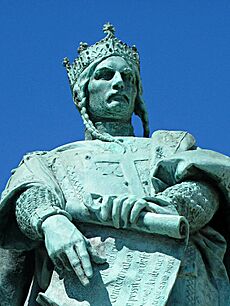
In 1228, Andrew allowed his son, Béla, to review his previous land grants. Béla took back lands from some noblemen who had been involved in Queen Gertrude's murder.
The Church continued to complain about Andrew employing Jewish and Muslim officials. Pope Gregory IX allowed the Archbishop of Esztergom to take action against Andrew. Under pressure, Andrew issued a new Golden Bull in 1231. This document confirmed that Muslims were not allowed to be employed in royal service. It also gave the Archbishop of Esztergom the power to excommunicate the king if he did not follow these rules.
In 1232, the Archbishop of Esztergom placed Hungary under an interdict. This meant that church services were stopped because Andrew still employed non-Christian officials. Andrew promised to return church property, and the interdict was lifted. The Pope sent a special representative to Hungary. On August 20, 1233, Andrew promised that he would not hire Jewish and Muslim officials and would pay money for church property he had taken.
Andrew's youngest son died in Halych in 1234. Andrew, who was a widower, married Beatrice D'Este in 1234. She was much younger, and his sons were strongly against this marriage.
Final Years (1234–1235)
Andrew stormed Austria in the summer of 1235, forcing the Duke of Austria to pay for damages. Andrew died on September 21, 1235, and was buried in Egres Abbey.
Family
Andrew's first wife was Gertrude of Merania. Their children were:
- Mary (born 1203 or 1204), who married Ivan Asen II of Bulgaria.
- Béla (born 1206), who became king after his father.
- Elisabeth (born 1207), who became a saint.
- Coloman (born 1208).
- Andrew (born around 1210).
Two years after Gertrude's death, Andrew married Yolanda de Courtenay. Their only child was:
- Yolanda (born around 1219), who married James I of Aragon.
Andrew's third wife was Beatrice D'Este. She was about 23 when they married in 1234. She gave birth to a son, Stephen, after Andrew's death. However, Andrew's older sons believed Stephen was not a legitimate heir. Stephen's grandson, Andrew, later became the last king from the House of Árpád.
Sources
Primary sources
- Anonymus, Notary of King Béla: The Deeds of the Hungarians (Edited, Translated and Annotated by Martyn Rady and László Veszprémy) (2010). In: Rady, Martyn; Veszprémy, László; Bak, János M. (2010); Anonymus and Master Roger; CEU Press; ISBN: 978-963-9776-95-1.
- Archdeacon Thomas of Split: History of the Bishops of Salona and Split (Latin text by Olga Perić, edited, translated and annotated by Damir Karbić, Mirjana Matijević Sokol and James Ross Sweeney) (2006). CEU Press. ISBN: 963-7326-59-6.
- The Hypatian Codex II: The Galician-Volynian Chronicle (An annotated translation by George A. Perfecky) (1973). Wilhelm Fink Verlag. LCCN 72-79463.
Secondary sources
- Fine, John Van Antwerp (1994). [Andrew II of Hungary at Google Books The Late Medieval Balkans: A Critical Survey from the Late Twelfth Century to the Ottoman Conquest]. Ann Arbor, Michigan: University of Michigan Press. ISBN 0-472-08260-4. Andrew II of Hungary at Google Books.
- Runciman, Steven (1989). A History of the Crusades, Volume II: The Kingdom of Jerusalem and the Frankish East. Cambridge: Cambridge University Press. ISBN 0-521-06162-8.
- Runciman, Steven (1989). A History of the Crusades, Volume III: The Kingdom of Acre and the Later Crusades. Cambridge: Cambridge University Press. ISBN 0-521-06163-6.
|
Andrew II of Hungary
House of Árpád
Born: c. 1177 Died: 21 September 1235 |
||
| Regnal titles | ||
|---|---|---|
| Preceded by Roman Mstislavich |
Prince of Halych 1188–1189 or 1190 |
Succeeded by Vladimir II Yaroslavich |
| Preceded by Ladislaus III |
King of Hungary and Croatia 1205–1235 |
Succeeded by Béla IV |
| Preceded by Roman II Igorevich (as prince) |
King of Halych 1208 or 1209–1210 |
Succeeded by Vladimir III Igorevich (as prince) |


